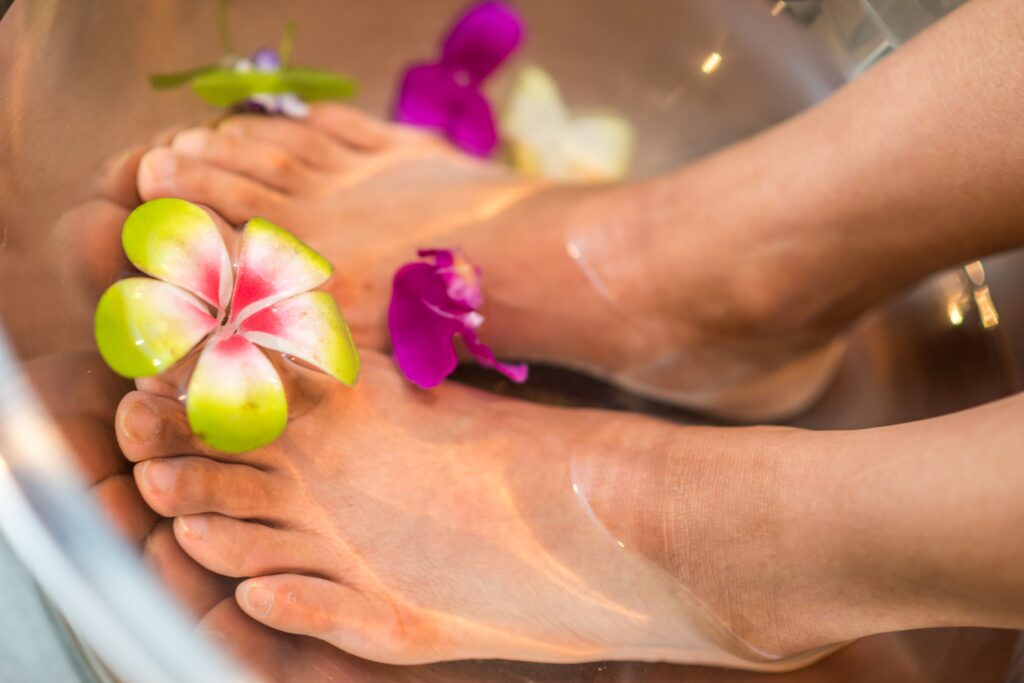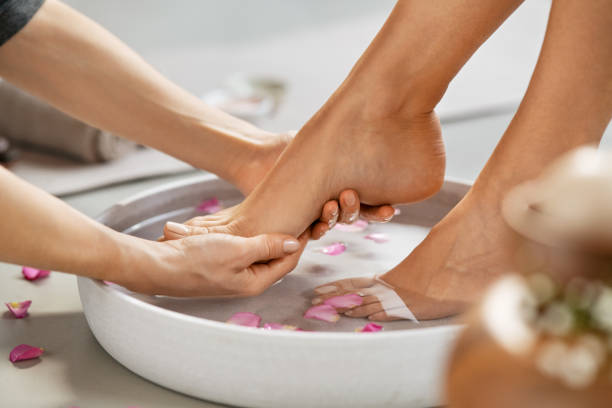A Foot's Journey: The Healing Power of Leg Massage

The Basics of Leg and Foot Massage
Leg and foot massage, often regarded as the unsung heroes of the massage world, is a specialized form of massage therapy that focuses on the lower extremities. This type of massage typically includes the feet, ankles, calves, and thighs. It can be done as a standalone treatment or as part of a full-body massage session.
Let’s explore the essential factors that should be on your radar when it comes to leg and foot massage.:
Techniques:
Various techniques are used in leg and foot massage to promote relaxation, reduce muscle tension, and improve circulation. These techniques may include:
Effleurage: This involves gentle, gliding strokes that help warm up the muscles and prepare them for deeper massage.
Kneading: Kneading involves squeezing and lifting the tissues to release tension in the muscles.
Friction: Friction techniques involve applying pressure with the thumbs or fingers to work on specific points or knots in the muscles.
Tapping: Gentle tapping or percussion can help stimulate circulation and relax the muscles.
Reflexology: Reflexology is a specialized technique that focuses on pressure points on the feet, which are believed to correspond to different areas of the body.
Benefits
Leg and foot massage offers a range of benefits, including:
Relaxation: The soothing touch of a skilled massage therapist can instantly relax your mind and body. It’s a fantastic way to de-stress and unwind.
Improved Circulation: Massage stimulates blood flow to the legs and feet, which can help with issues like cold feet and swelling.
Muscle Tension Relief: If you experience muscle tightness, knots, or discomfort in your lower extremities, massage can help alleviate these issues.
Stress Reduction: Foot massage, in particular, can trigger relaxation responses in the body, reducing stress and anxiety.
Enhanced Flexibility: Regular leg and foot massage can improve the flexibility of your ankles and reduce the risk of injury.
The Art of Reflexology
Reflexology is a fascinating aspect of leg and foot massage. This ancient practice is based on the idea that specific points on the feet correspond to different parts of the body. By applying pressure to these points, it’s believed that a reflexologist can promote healing and balance in the associated areas.
Reflexology sessions are known for their therapeutic effects, often helping with issues like digestive problems, headaches, and even chronic pain. While reflexology can be a standalone treatment, it’s often incorporated into leg and foot massage for a more holistic experience.
Self-Massage Techniques
You don’t always need a massage therapist to enjoy the benefits of leg and foot massage. There are simple self-massage techniques you can use to relieve tension and promote relaxation in your lower extremities. Here’s a basic routine you can try at home:
1. Gather Your Supplies:
- A comfortable chair
- A towel or blanket
- Massage oil or lotion (optional)
2. Prepare Your Environment:
- Sit in a quiet, comfortable space with good lighting.
3. Warm-Up:
- Begin by soaking your feet in warm water for 10-15 minutes. This helps relax the muscles.
4. Begin with Effleurage:
- Apply a small amount of massage oil or lotion to your hands and gently stroke your legs from the feet to the thighs using long, sweeping motions.
5. Kneading:
- Use your fingers and thumbs to knead the muscles of your feet, working your way up to your calves and thighs. Pay attention to any tight or sore spots.
6. Heel and Arch Massage:
- Focus on the arches of your feet and your heels, using your thumbs to apply gentle pressure in a circular motion.
7. Ankle Mobility:
- Rotate your ankles in both directions to improve flexibility.
8. Toe Stretching:
- Gently stretch and wiggle your toes to relieve tension.
9. Cooling Down:
- Finish your self-massage with a few minutes of gentle effleurage to relax your muscles.
Self-massage can be an excellent way to unwind at the end of a long day and is a great addition to your self-care routine.
Choosing a Professional Therapist
While self-massage has its benefits, there’s no substitute for the skilled hands of a professional massage therapist. When seeking a therapist for leg and foot massage, consider the following factors:
Certification and Licensing: Ensure that the therapist is certified and licensed to practice massage therapy in your area.
Experience: Look for therapists with experience in leg and foot massage or reflexology.
Client Reviews: Read reviews and ask for recommendations to find a therapist with a positive reputation.
Communication: Prior to your session, communicate any specific concerns or areas you’d like the therapist to focus on.
Safety Precautions
Leg and foot massage is generally safe, but there are some precautions to keep in mind:
Avoid Excessive Pressure: Gentle to moderate pressure is typically used during leg and foot massage. Avoid therapists who use excessive force.
Injuries and Medical Conditions: If you have any injuries, medical conditions, or recent surgeries involving your legs or feet, consult your healthcare provider before getting a massage.
Pregnancy: If you are pregnant, it’s important to inform your therapist, as there are specific techniques and pressure points that should be avoided during pregnancy.
Aftercare
After a leg and foot massage, it’s important to continue your self-care to maximize the benefits. Here are some tips for post-massage care:
Stay Hydrated: Drink plenty of water to help flush out toxins released during the massage.
Rest and Relax: Take some time to relax after your massage. Avoid strenuous activities immediately afterward.
Light Physical Activity: Engage in light physical activities, such as walking or stretching, to maintain the relaxation and flexibility gained from the massage.
Foot Care: If your massage included reflexology, you might experience enhanced energy and well-being in the days following the session. Continue to take care of your feet to prolong the benefits.
Conclusion
Leg and foot massage is a valuable practice that can contribute to your overall well-being. Whether you choose self-massage, professional massage therapy, or reflexology, the benefits are numerous, from relaxation and stress reduction to improved circulation and muscle tension relief.
By incorporating leg and foot massage into your self-care routine, you’re not only treating your lower extremities but also nurturing your entire body and mind. So, why wait? Give your legs and feet the attention they deserve, and experience the transformational power of this ancient and therapeutic practice. It’s time to step into your own sole sanctuary.
- 1 Hour Full Body Massage
- 1/2 Hour Deep Tissue
- 1/2 Hour Back Massage
- 1/2 Hour Swedish Massage
- Traditional Thai Massage
- Aromatherapy oil Massage
- Body Scrub
- Sports Massage
- Herbal bag hot massage
- Body Massage Centres in ANDHERI (EAST)
- Body Massage Centres in ANDHERI (WEST)
- Body Massage Centres in SAKINAKA
- Body Massage Centres in CHAKALA
- Body Massage Centres in POWAI
- Body Massage Centres in GHATKOPAR
- Body Massage Centres in AZAD NAGAR
- Body Massage Centres in AMBOLI
- Body Massage Centres in KURLA
- Body Massage Centres in JUHU

